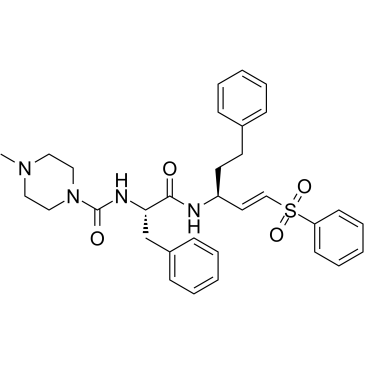K777
Modify Date: 2025-09-12 19:42:04

K777 structure
|
Common Name | K777 | ||
|---|---|---|---|---|
| CAS Number | 233277-99-1 | Molecular Weight | 574.73 | |
| Density | N/A | Boiling Point | N/A | |
| Molecular Formula | C32H38N4O4S | Melting Point | N/A | |
| MSDS | N/A | Flash Point | N/A | |
Use of K777K777 is a potent, orally active and irreversible cysteine protease inhibitor. K777 is also a potent CYP3A4 inhibitor with an IC50 of 60 nM and a selective CCR4 antagonist featuring the potent chemotaxis inhibition. K777 irreversibly inhibits Cruzain, the major cysteine protease of Trypansoma cruzi, and cathepsins B and L. K777 is a broad-spectrum antiviral by targeting cathepsin-mediated cell entry. K777 inhibits SARS-CoV and EBOV pseudovirus entry with IC50 values of 0.68 nM and 0.87 nM, respectively[1][2][3]. |
| Name | K777 |
|---|---|
| Synonym | More Synonyms |
| Description | K777 is a potent, orally active and irreversible cysteine protease inhibitor. K777 is also a potent CYP3A4 inhibitor with an IC50 of 60 nM and a selective CCR4 antagonist featuring the potent chemotaxis inhibition. K777 irreversibly inhibits Cruzain, the major cysteine protease of Trypansoma cruzi, and cathepsins B and L. K777 is a broad-spectrum antiviral by targeting cathepsin-mediated cell entry. K777 inhibits SARS-CoV and EBOV pseudovirus entry with IC50 values of 0.68 nM and 0.87 nM, respectively[1][2][3]. |
|---|---|
| Related Catalog | |
| Target |
Cysteine protease[1][2][3] IC50: 60 nM (CYP3A4)[3] CCR4[3] |
| In Vitro | K777 (K11777) can inhibit entry driven by other viral envelope proteins, HIV-based pseudotypes bearing spikes from coronaviruses (SARS-CoV, HCoV-229E, NL63, MERS-CoV) or glycoproteins from filoviruses (EBOV, SUDV, TAFV, RESTV, BEBOV and MARV) are examined. K777 inhibits SARS-CoV, HCoV-229E, NL63, MERS-CoV, EBOV, SUDV, TAFV, RESTV, BEBOV, MARV and Nipah pseudovirus entry with IC50 values of 0.68 nM, 1.48 nM, 6.78 nM, 46.12 nM, 0.87 nM, 1.14 nM, 2.26 nM, 3.37 nM, 5.91 nM, 1.9 nM and 0.42 nM, respectively. In contrast, 100 nM K777 does not inhibit infection mediated by envelope glycoproteins from an alphavirus (CHIKV), a rhabdovirus (VSV), a flavivirus (HCV), the retroviruses MLV-A and XMRV or two arenaviruses, Lassa and Junin virus[1]. Whether K777 displays antiviral activity in TMPRSS2 expressing cells are assessed. For this, the incubated target cells with Camostat, K777, or a combination of K777 and Camostat and then infected with pseudoviruses bearing 229E-S. K777 alone demonstrates up to ~ 70% inhibition of 229E-S-mediated transduction. Simultaneous treatment with Camostat and K777 increases inhibition to ~ 90%. Similar inhibition patterns are obtained using the human intestinal epithelial cell line Caco-2, which express endogenous TMPRSS2 and cathepsins[1]. K777 inhibits both CCL17 binding and CCL17-induced chemotaxis in Hut78 cells (IC50 of 57 and 8.9 nM, respectively). The K777-mediated inhibition of chemotaxis is potent even in the presence of a 10-fold higher concentration of CCL17. K777 induces CCR4 internalization, with a ∼50% reduction of cell surface CCR4. K777 does not inhibit CXCR4-induced chemotaxis or internalization and did not bring about Ca2+ mobilization by itself[3]. |
| In Vivo | K777 (K11777; 35-105 mg/kg; oral administration; twice a day; for 10 days; C57BL/6 IFN-γR-KO mice) treatment rescues mice from otherwise lethal infections[4] . Animal Model: C57BL/6 IFN-γR-KO mice (6-8 weeks of age) injected with Cryptosporidium parvum[4] Dosage: 35 mg/kg, 70 mg/kg, and 105 mg/kg Administration: Oral administration; twice a day; for 10 days Result: Rescued mice from otherwise lethal infections. |
| References |
| Molecular Formula | C32H38N4O4S |
|---|---|
| Molecular Weight | 574.73 |
| Hazard Codes | Xi |
|---|
| MFCD14105618 |